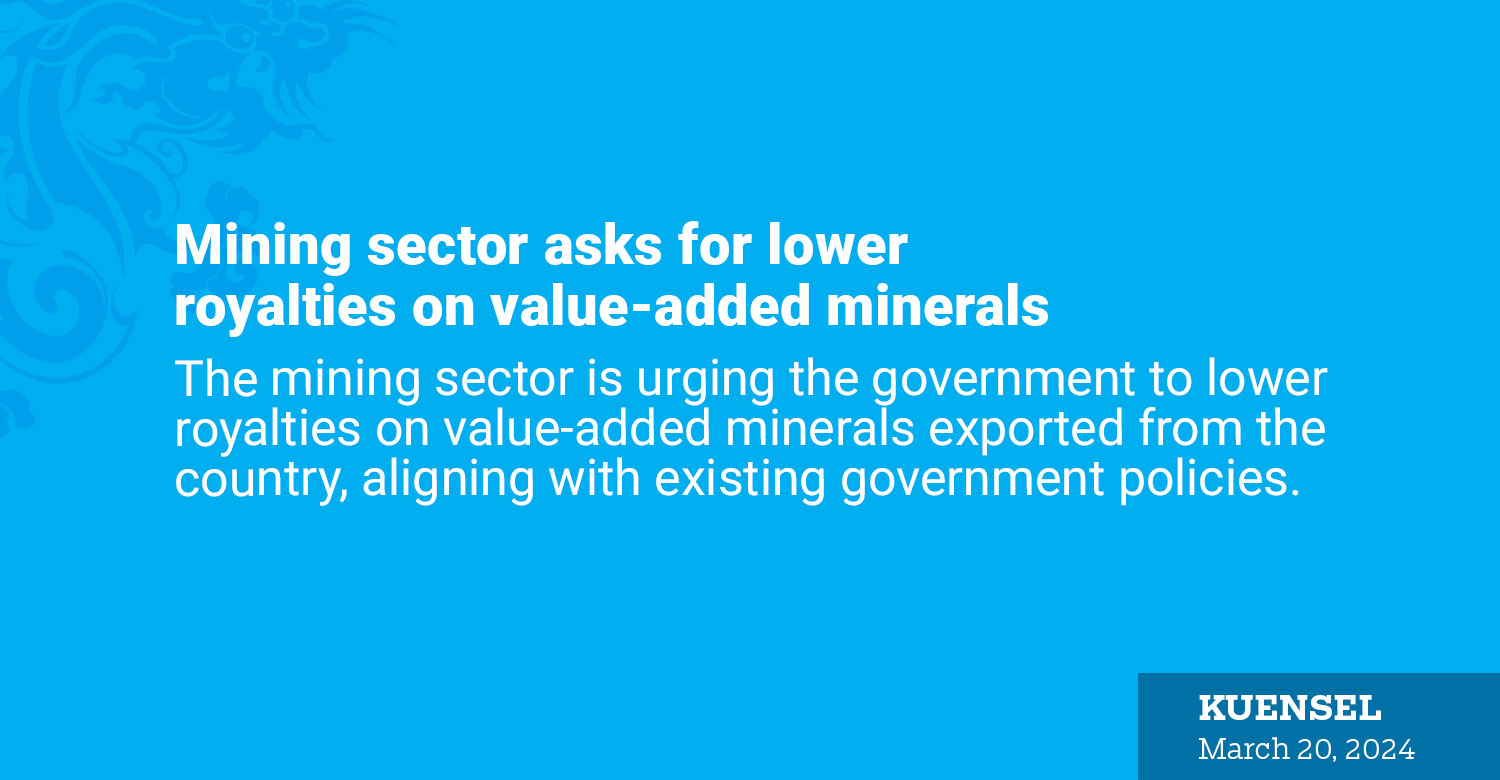
The mining sector is urging the government to lower royalties on value-added minerals exported from the country, aligning with existing government policies.
The people from the industry say that the royalty and mineral rent for the export of value-added minerals in the country are more than those for raw ones. This contradicts the government policies—Mineral Development Policy and Economic Development Policy.
For instance, when limestone or marble is exported to Bangladesh in its raw form, the royalty and mineral rent charged is Nu 221 per metric tonne (MT), which is 25 percent less than when it’s in powdered form (value-added), where the charge is Nu 276 per MT. This calculation is based on the ex-Phuentsholing minimum floor prices set at Nu 2,510 per MT in raw form and Nu 3,135 per MT in powdered form.
Meanwhile, when dolomite is exported to Bangladesh in raw form, the charge is Nu 76 per MT, which is 122 percent lower than the charge for powdered dolomite, which is Nu 169 per MT.
In the case of talc and gypsum, when they are exported in raw form, the charges are Nu 193 per MT and Nu 259 per MT respectively. These charges are 35 percent lower for talc and 26 percent lower for gypsum compared to when they are exported in powdered form, where the charges are Nu 261 per MT for talc and Nu 330 per MT for gypsum.
Representatives from the sector have expressed that the current system of charging higher royalty and mineral rent on minerals that have undergone value addition contradicts government policies.
As per the Mineral Development Policy of 2017, it encourages a policy on adding value to minerals within the sector. Section 3.7.4 of the policy specifies that the government shall levy lower royalty for in-country value addition and use.
Additionally, Section 3.7.1 of the policy also states that the export of minerals in their primary form should be discouraged. However, minerals that cannot be utilised as raw materials for local industries or supplied to other domestic industries as additives may be allowed for export.
The promotion of value addition in minerals was also adopted in the Economic Development Policy of 2016. Section 7.4.5 of the policy stated that the government shall levy lower royalty for in-country value addition and higher for the export of unprocessed minerals where permitted. However, the government can revise the royalty for minerals periodically based on the market value of the resources.
Previously, when the royalty and mineral rent for minerals were fixed at a certain rate, there was not much issue.
However, starting from June 1, 2016, when the government implemented the revised Taxes and Levies Act of Bhutan 2016, the royalty and mineral rent for minerals and construction grade materials exported from Bhutan were updated to be based on a new ad-valorem taxation system.
This means that the charges are now calculated as a percentage of the value of the minerals being exported.
Under the revised royalty and mineral rent structure, dolomite and limestone were subjected to a royalty of 6.5 percent and 8 percent per MT respectively, along with other minerals. Additionally, an amount equivalent to 10 percent of the projected export royalty or domestic royalty, whichever is higher, was charged as mineral rent.
In 2019, the government implemented royalty and mineral rent regulations specifically for value-added products being exported. Before this, such products were charged the domestic royalty and mineral rent rates, which were considerably lower than the rates for exports. This was because these products were seen as coming from captive mines.
“This revision in the royalty and mineral rent regime effectively means that there is no incentive to process and value add to make powdered minerals and that it would be better to export minerals in the raw form,” a representative said.
The mining industry argued that powdered mineral products should be viewed as value-added goods, both according to the Mineral Development Policy’s definition and considering the investments made by proponents. They emphasised that these investments also generate job opportunities.
The issue can be addressed only after discussion and amendment of the Bhutan Taxes and Levies Act 2016 in the Parliament. Whether the government decides to address it is crucial.
The Mines and Mineral Management Regulations 2022 states that the government shall levy lower royalty for in-country value addition of minerals upon approval by the Parliament.












